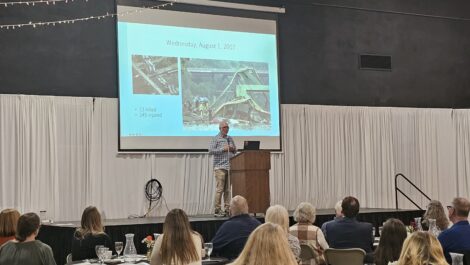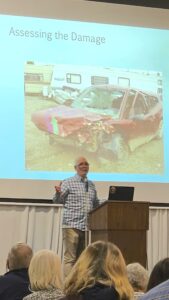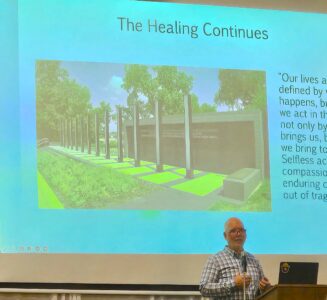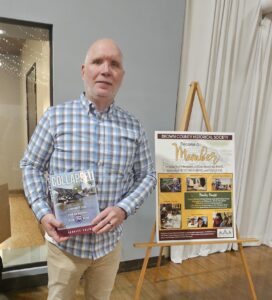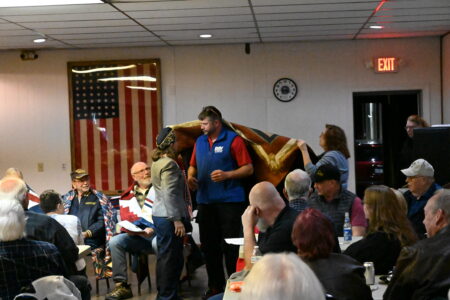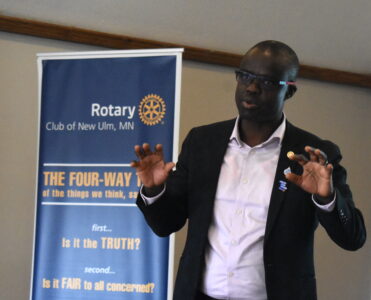I-35 Bridge survivor shares 18-year journey through trauma

Garrett Ebling’s vehicle, a red sedan, lies in the wreckage of the I-35W bridge collapse—shown here during his keynote at Turner Hall. Thirteen lives were lost, 145 injured.
NEW ULM — Community members who filled Turner Hall on Thursday for the Brown County Historical Society’s 95th Annual Meeting listened to Garrett Ebling share a story that began with catastrophe — and unfolded into a long, often invisible battle for healing.
Ebling, who has roots in New Ulm, was one of 145 people injured when the Interstate 35W bridge collapsed into the Mississippi River on Aug. 1, 2007. Thirteen people died. Ebling was pulled from the wreckage with life-threatening injuries and spent 18 days in a medically induced coma. But as he told the audience, the hardest part came after the bones healed.
“I kept thinking once I could walk again, once I got out of the wheelchair, I’d feel better inside,” he said. “It never happened.”
Ebling’s recollection of the collapse came in fragments — not because he forgot, but because the memory still lived in his body more than his words. He described the heat first.
“I remember sweating the whole time,” he said. He’d been out earlier, maybe at the zoo. The details blurred, but the feeling stuck — the kind of sticky, restless heat that makes you roll down the windows and shift in your seat.
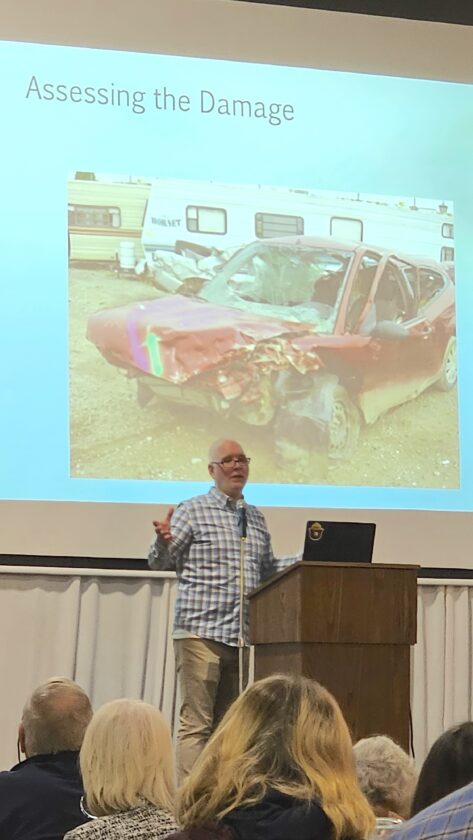
Garrett Ebling discusses the aftermath of the I-35W bridge collapse, showing the wreckage of his vehicle during his keynote at Turner Hall.
He wasn’t familiar with the area. The bridge was undergoing resurfacing work, and four of its eight lanes were closed for construction. Jersey barriers lined the sides, blocking the view of the river below. “You couldn’t really see where you were,” he said. “It just felt like another stretch of highway.”
Traffic slowed. He considered taking the next exit, trying to beat the congestion and get home faster. But his destination was on the other side of the bridge, so he stayed in the far-right lane, inching forward with the rest of the commuters.
Then something shifted.
“All the brake lights came on at the same time,” he said. “That’s when I knew something wasn’t right.”
He saw the cars in front of him drop — not swerve, not crash, but disappear. “It was like watching something on a cable,” he said. “They just dropped straight down.”
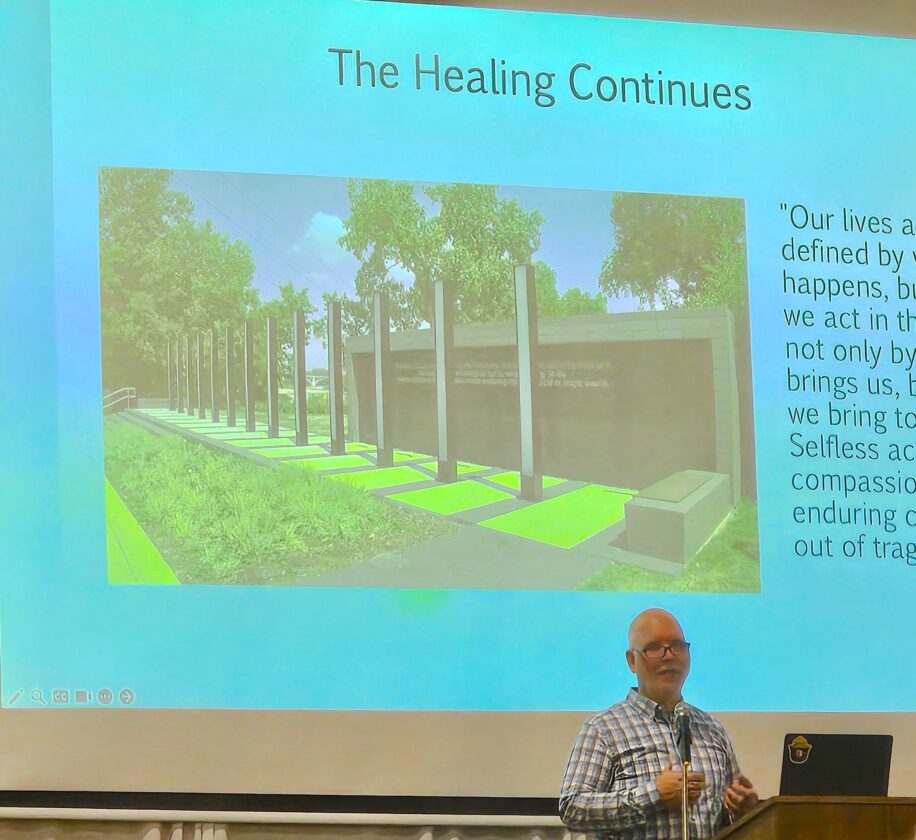
The I-35W Remembrance Garden in Minneapolis sits along West River Parkway, east of the Guthrie Theater and north of Gold Medal Park. The memorial honors victims of the 2007 bridge collapse and reflects themes of resilience and compassion.
The brain does not process that kind of sight easily. Ebling described it as surreal, like a cartoon physics moment — Wile E. Coyote running off a cliff and hanging in midair before falling.
“I had my arms locked in the steering wheel,” he said. “My foot slammed on the brake. I didn’t know what was happening, but I knew it was bad.”
Dust and debris filled the air. He couldn’t see, but he could feel his car lurch forward. The section of bridge ahead had vanished. His vehicle was perched on a remaining pier, the structure beneath him groaning, unstable.
“I didn’t know if I was falling into a river or just dropping a few feet,” he said. “I didn’t have a concept of falling off a bridge. I thought I was still on a highway.”
And then, darkness.

Garrett Ebling holds a copy of Collapsed, his memoir recounting survival and recovery after the I-35W bridge collapse, during the Brown County Historical Society’s annual gathering.
Ebling’s injuries were staggering: every bone in his face was fractured, his colon was partially removed, and he suffered a traumatic brain injury, broken ribs, a shattered ankle and more. His facial surgeon later told him that on a scale of one to 10 for facial trauma — where most patients score between three and four — Ebling would have been a 13.
“They don’t score past 10,” Ebling said, “because most people don’t survive injuries that severe.”
By November 2007, just three months after nearly dying, Ebling returned to work part-time. He married Sonja Birkeland a year and two days after the collapse. From the outside, it looked like recovery, but inside, he was falling apart.
By Christmas, Sonja urged him to seek help. He was diagnosed with adjustment disorder — a form of PTSD for those whose trauma doesn’t meet all the clinical criteria. Ebling didn’t take it seriously.
“I thought, ‘I’ll do therapy for six months, do the work, and I’ll be done,'” he said. “Like physical therapy. I didn’t give it much serious attention.”
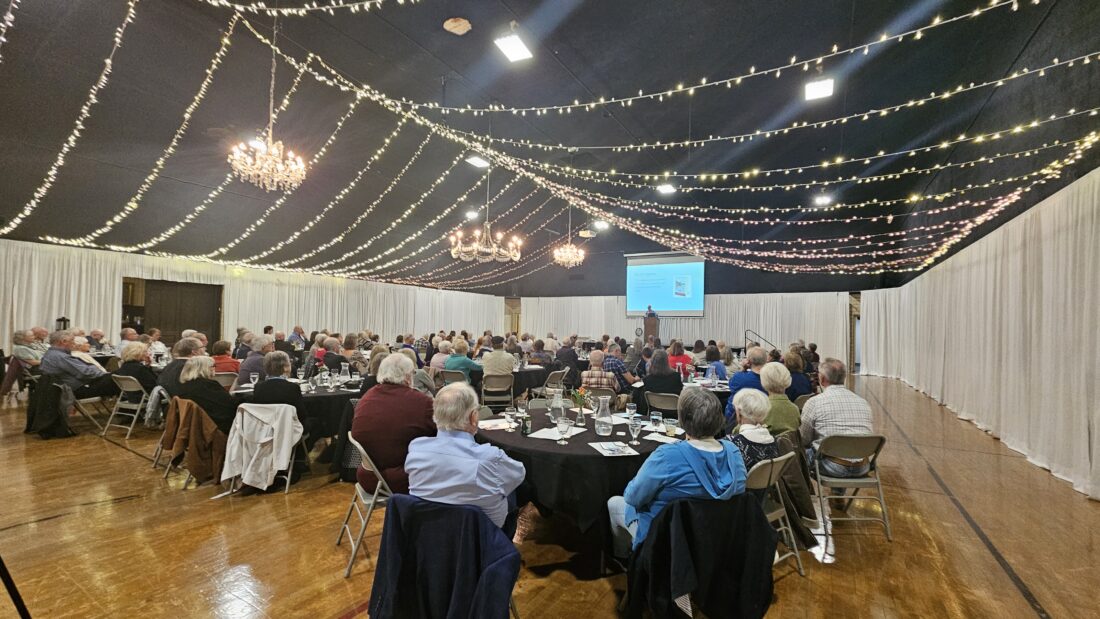
Attendees listen as Garrett Ebling shares his journey of survival and recovery following the I-35W bridge collapse, during the Brown County Historical Society’s annual gathering at Turner Hall.
That denial had consequences. He became volatile, overwhelmed by triggers as small as a change in plans.
“Any situation where I lost control would take me back to the bridge,” he said. “I would just explode.”
He buried himself in work, opening a restaurant and clocking 14 to 16 hours a day. But the emotional strain fractured his marriage. The eventually divorced in 2015.
“I looked at my life and thought, ‘OK, what’s the common denominator here?'” he said. “And I realized: it’s me.”
That realization marked a turning point. Ebling began studying the teachings of Thich Nhat Hanh, the Vietnamese monk who transformed his own trauma into a philosophy of peace. Ebling developed a “mental health pyramid” with three layers: understanding trauma, recognizing triggers and mastering responses.
“If I didn’t understand trauma, I wasn’t going to be able to defeat it,” he said. “I had to know what situations were likely to trigger me so I could stop myself before I said or did something that damaged another relationship.”
Mindfulness became a lifeline. He described moments when simple awareness — like noticing his breath while washing dishes — helped him stay grounded.
“I used to think mindfulness was just a buzzword,” he said. “Now I see it as a survival tool.”
Ebling also spoke about survivor’s guilt — the emotional weight of living when others didn’t.
“I felt like if I was happy, I didn’t respect the people that died,” he said. “But I eventually found peace by reframing my survival not as a question of worthiness, but as an opportunity for purpose.”
That purpose now includes helping others. He runs a website and podcast focused on trauma recovery, and his memoir, “Collapsed: A Survivor’s Climb From the Wreckage of the 35W Bridge,” includes stories from other survivors.
“Some people were surprised at how willing they were to talk about it,” he said. “I think people don’t talk about mental health enough. We feel like we can’t talk about it — that people don’t want to hear it.”
Ebling’s advocacy is rooted in lived experience. He’s learned to navigate triggers, rebuild relationships and accept that healing isn’t linear.
“I’m never going to be healed in the sense that everything goes back together again,” he said. “I had to accept this new version of myself.”
He closed the evening with a message of ongoing growth.
“My journey continues every day,” he said. “I still feel like I’m finding my feet. But maybe that’s the point — to keep learning, keep growing, keep helping others who are struggling to find theirs.”
Ebling said the bridge collapse is not something he would want to go through again, but acknowledge he gain perspective from the experience.
“It gave me a path I didn’t have before,” he said.
The I-35W bridge collapse led to nationwide inspections of aging infrastructure and prompted changes to bridge safety regulations across the country.
- Garrett Ebling’s vehicle, a red sedan, lies in the wreckage of the I-35W bridge collapse—shown here during his keynote at Turner Hall. Thirteen lives were lost, 145 injured.
- Garrett Ebling discusses the aftermath of the I-35W bridge collapse, showing the wreckage of his vehicle during his keynote at Turner Hall.
- The I-35W Remembrance Garden in Minneapolis sits along West River Parkway, east of the Guthrie Theater and north of Gold Medal Park. The memorial honors victims of the 2007 bridge collapse and reflects themes of resilience and compassion.
- Garrett Ebling holds a copy of Collapsed, his memoir recounting survival and recovery after the I-35W bridge collapse, during the Brown County Historical Society’s annual gathering.
- Attendees listen as Garrett Ebling shares his journey of survival and recovery following the I-35W bridge collapse, during the Brown County Historical Society’s annual gathering at Turner Hall.

